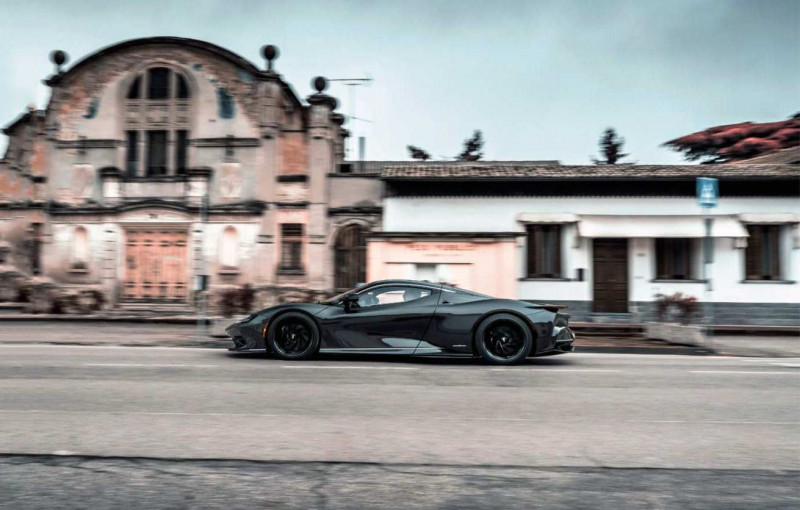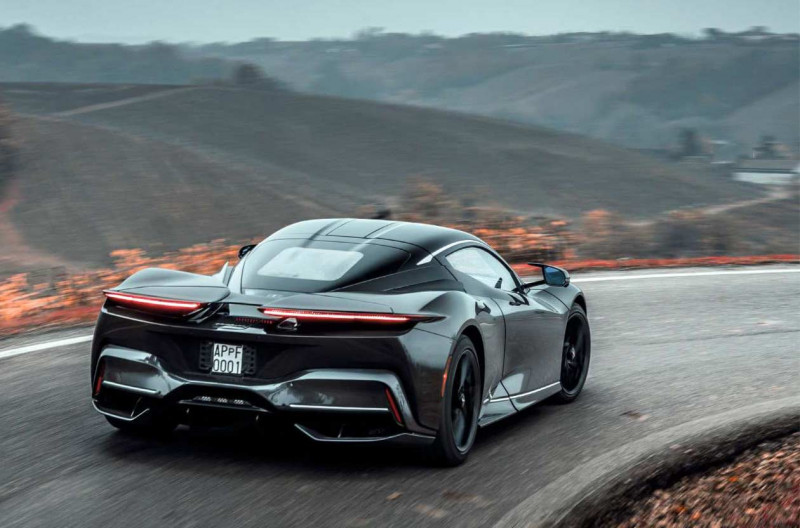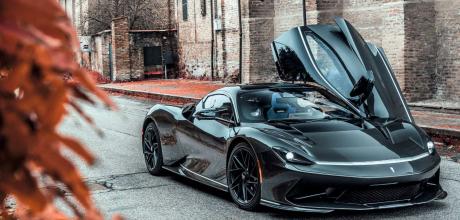300-mile test Pininfarina’s wild Battista
The design legends become car makers with the Battista: a £2m, 1874bhp electric hypercar. Our mission: try very hard not to crash it.
Electric avenue — We drive Pininfarina’s outrageous 1874bhp EV
PININFARINA BATTISTA
Words Ben Barry Photography Olgun Kordal
This story isn’t only about nearly crashing a hypercar worth two million pounds. I won’t dwell on turning hard left when I was planning to turn hard right, or the grass and the wall and begging for it to stop. Because this is a story about much more than that. It’s about the Pininfarina Battista. Limited to 150 units, priced €1.98m plus taxes, handbuilt in Cambiano, Italy, it’s the first car from legendary Italian design house Pininfarina, despite the company designing for the likes of Ferrari and Lancia over a 90-year timespan. And it’s about the challenges of engineering an all-electric hypercar that produces 1874bhp, how it drives on the road, and how alien and phenomenal it is when you pull the trigger on all that performance on track. But yeah, almost crashed it.
It’s the acceleration that stays with you – enough to make a Bugatti Chiron blanch

That power output is not a typo, by the way: the Battista produces one thousand eight hundred and seventy four brake horsepower, its 1696lb ft torque is another not-a-typo, and it’s all as accessible as flicking a light switch. The Battista accelerates from 0-62mph in sub-two, smashes 0-124mph in sub-six, tops out at 217mph, and covers up to 320 miles on a charge, though obviously it won’t do both simultaneously. Other figures are wow for the wrong reasons: the Battista’s kerbweight is around 2.2 tonnes (hundreds heavier than a Lotus Evija, comparable to the Rimac Nevera), it measures five metres nose-to-tail, and while luggage space isn’t quoted, let’s just say my coat was pretty cosy back there.

It’s the acceleration that stays with you – enough to make a Bugatti Chiron blanch, as well as yours truly when passengering with ex-Formula 1 and Formula E driver Nick Heidfeld around Circuito Tazio Nuvolari. Heidfeld’s been on-board since day dot, periodically feeding back on development while a larger dynamics team does the day-to-day. The link? Heidfeld raced for Mahindra Racing in Formula E, and then its parent Mahindra & Mahindra bought a majority stake in Pininfarina in 2014. When Mahindra boss Anand Mahindra and Pininfarina chairman Paolo Pininfarina agreed to realise founder Battista Pininfarina’s dream of creating a car, they founded Automobili Pininfarina and needed a test driver. Nick! Now a pre-series Battista is in the pitlane, pulsing and throbbing with an artificial soundtrack almost like a high-performance car idling, bass rhythmically tingling the diffuser.
The design is strikingly well resolved for what in some ways is a first attempt, if not shown in its best light in our test car’s black. Design is crucial here, because really the Battista harks back to Pininfarina’s core skillset as a coachbuilder, and under its carbonfibre body lies hardware designed and engineered by Rimac, the Croatian electric hypercar maker. Just like Rimac’s Nevera, a carbonfibre passenger cell packages a T-shaped 120kWh lithium-ion battery, the stem of the T following the spine of the car like a propshaft might, the cross extending behind the seats. It allows the seats to be far lower than they would be with a conventional ‘skateboard’ EV battery platform. Each axle has two electric motors with its own single-speed gearbox, and there are five radiators – one for each motor, another for the battery. Double-wishbone suspension is attached to aluminium crash structures front and rear, again just like the Nevera, but chassis tuning, the way software manages it all, that’s Automobili Pininfarina special sauce. The Battista is not billed as a track car, rather a ‘pure-electric hyper GT’, so it’s appropriate our first leg is on the road, wearing the winter tyres mandatory in Italy at this time of year.
Dihedral doors remove a chunk of roof as they rise, making climbing aboard relatively straightforward, and you settle into those low seats with useful comfort and generous lateral support. Two large infotainment screens are angled in a V shape ahead of the steering wheel, and between them a smaller portrait-orientated screen displays speed. It’s a smart, driver-focused layout, although the steering wheel obscures a portion of the screens. Rotary controllers like afterburners sit at elbow height on either side – on the right for Park, Reverse and Neutral, on the left to adjust five drive modes (Calma, Pura, Energica, Furiosa and the individually configured Caraterre), which hike performance up in increments of 21 per cent of the maximum, then 53 per cent and 71 per cent, before finally uncorking the full 1874bhp. Quality seems decent, if a long way from the steampunk jewellery of a Pagani.
We thread through industrial towns and Northern Italian flatlands up towards the more challenging topography of Montalto Pavese, where muted autumnal colours merge with (thankfully) dry grey tarmac like paint mixed on a palette. The Battista reveals itself to be an undemanding car to drive steadily. Its steering is light, more accurate than feelsome, with a measured rate of response away from the dead-ahead, which is probably for the best, and brakes that are similarly well judged, with a small amount of give at the top of the pedal. The primary ride flows beautifully in Pura mode, but toughens up in Energica; I use the harder setting only briefly.
It takes time to adapt to one-pedal driving, because you’re mostly easing in and out of the throttle like Hendrix finessing a wah-wah pedal – you have to be very precise. The soundtrack is a little disquieting, like the threatening digital soundscape of Bladerunner 2049, but with it off, other noises fill the vacuum: the distant whir of electric motors, flecks of road debris, water swilling about in the cooling system when you stop at the lights. All authentic, all very alien.
We head up to the twists above Montalto Pavese, where the Battista feels, and is, a very wide car, not helped by flamboyant mirrors that hinder vision through bends. Gnarled frost-bitten sections send raw thumps up into the carbon chassis, like extra isolation wouldn’t go amiss in something billed as a GT, but when the road flows it is phenomenal – the body is like a perfectly aligned spirit level over the bumps, and you burst forwards on a wave of performance that doesn’t seem to stress these squishier winter tyres despite such brute force. It just goes stupidly quickly and then goes faster still when you apply more throttle. This is performance with the elasticity of bungee jumping – a huge freefall surge of speed, and the twang back when you release the throttle and regen kicks in.
The Battista is more dexterous and involving than a numbers car built to obliterate straights, but not entirely in the mid-engined fashion the design fools you into expecting. It turns in like both front tyres are keeping all their contact patch firmly on the surface, stays flat because so much weight is positioned low down and is split 48/52 front-to-rear, then soaks up the stress when you’re relatively early on the throttle (though you suspect giving it everything with some lock applied is a bad idea). It’s even surprisingly good at suppressing torque steer, given the brute force flooding through the front axle. The problem is the sense that there’s so much left to uncork.
Back at a slightly damp track we switch first to Michelin Pilot Sport 4S tyres, and I ease myself in with Energica mode’s modest 1341bhp and 1393lb ft. On the long start-finish straight the Battista gathers speed with a surreal mix of crushing force and total calm – it is rock-solid, tracks straight and true, but there’s speed like you’re accelerating a jet, sound rushing to catch up. Spotting your braking point is tricky – at first I’m early, but when I leave it just a little later the speed has increased so dramatically it feels uncomfortably late.
This much I kind of expected. What I couldn’t imagine was how the Battista would behave when you push it to the limit in a corner, get the body moving, then add throttle, like you would to balance a normal car that’s getting frisky. In truth it’s a bit odd, at least on the 4S tyres. The spectacularly flat turn-in is still evident, but now the tyres and systems are fighting with the performance in tighter turns. In theory there’s torque vectoring and stability control giving each tyre precisely what it needs, but it feels more like four watch mechanisms being independently wound up, and there’s a lot going on to stop the body yawing about. Similarly, it’s a heavy car to get stopped, and the hard-working ABS adds another sense of punctuation. It’s not very fluid, and I trigger limp mode several times as the electronics and the power battle, something that’s apparently being worked on ahead of the imminent start of production. Furiosa mode is better. It unleashes the full 1874bhp, and naturally there’s the kick of even more violent acceleration, but it’s still kind of abstract, like Starship Enterprise warp mode – I don’t get a sense of the nose raising and tyres chewing the surface in a straight line; it almost floats forwards supernaturally.
The handling is much more convincing when the track dries, the Cup 2 Rs go on and I turn all the stability control off. The extra mechanical traction lets the slightly clunky systems fade into the background, so the Battista flows and turns more eagerly, and it feels more rear-biased, which apparently it isn’t – but there’s a nicer sense of working against the traction, having it bleed away progressively.
It is brain-mashingly rapid to lap this little track, but there’s also the sensation of being strapped into one of those g-force machines for astronauts, whizzing round faster and faster, impressed by the ridiculousness of it all but feeling slightly nauseous from the sheer relentlessness of acceleration and wondering if something slower and lighter with finer throttle control wouldn’t be more fun.
Then it all goes wrong. I accelerate from a quick left-right sweeper, gather more speed on the next straight that the Battista compresses into an eye blink, then brake late and hard (by my standards) for the next hard right, keeping it straight and near the kerb to the far left. I didn’t sense the rear going light, but it overtook the front in a split second like I’d pulled the handbrake, and I remember how all that weight felt so evenly distributed as I lost control, not teetering and dragging round like a thrown hammer. The skid marks show I wound on opposite lock just as I hit the grass, and I remember playing with the steering a bit but just basically waiting for impact, sliding for a while, then stopping with maybe two metres spare before two million quid clattered down a wall.
Thankfully I’m not entirely at fault, as the skid marks showed thick black lines from the rear tyres, and the data revealed an ABS software failure 30 seconds before I went off, so the tyres locked and with the sheer rate at which things were happening, well, I’m not sure I had time to react. And on the bright side, I drove pretty well for 30 seconds beforehand.
Ultimately it’s the electronic integration and calibration that still feels quite raw in this pre-series Battista, really more on the handling side than braking, but it all needs bringing together more cohesively. They’re working on that ahead of the production cars reaching customers, which is mind-boggling stuff to get right, but at this price it has to be perfect.
Wide as well as long and heavy for a two-seater with minimal bag space. Electric powertrain is from Rimac, lords of all the big numbers Low-down seating position is spot-on. We have Nick Heidfeld to thank for that.
Not a track car, but where else can you push a 1874bhp car? Steering is accurate more than feelsome
- Pick-up: 0 milesFirst glimpse of Battista in the Circuito Tazio Nuvolari pitlane. Striking, well resolved and a mid-engined-inspired design. Also very large at five metres long.
- 5 miles Some familiarisation time with Quick Nick Heidfeld at the wheel, ex-F1 and Formula E and now Battista superstar development driver. It’s the most powerful car he’s driven.
- 5.5 miles Time to hit the road. Luckily photographer Olgun is in a support car, because there’s barely room for my coat, despite the large dimensions. Reminds me of a Ford GT’s ‘boot’.
- 34 miles Mostly easy to drive on the road, with supple primary ride, light steering and easy acceleration. We’ve got just the 999bhp in Pura mode, but blimey it’s rapid.
- 40 miles The e-soundtrack gets more vigorous as you progress through the modes. So too the suspension. Energica setting stiffens the dampers and takes away some flow.
- 62 miles Up in the hills above Montalto Pavese. Some raw thumps through the chassis here. On flowing sections the impressive body control makes the outlandish performance more usable.
- 64 miles Corners spookily flat, but the Battista doesn’t feel like a mid-engined car, despite its design. Weight feels lower and much more evenly distributed, which it is.
- 95 milesBack at the track to chat with Swedish CEO Per Svantesson – ex-Volvo, Valeo, and NEVS, where he oversaw a deal with Koenigsegg. Seems a genuine, nice chap, and is easy company.
- Drop-off: 120 milesSpeed like a fighter jet on track, corners nice and flat, but electronic systems are a bit clunky when juggling grip in tighter corners. Go on, just one more lap. Uh oh…
Not a track car, but where else can you push a 1874bhp car? Steering is accurate more than feelsome
There’s a bungee-style freefall surge of speed, and a twang back when you release the throttle
PAST, PRESENT AND FUTURE MEET
Design chief Luca Borgogno explains how Automobili Pininfarina’s first car took shape
Why use mid-engined proportions when there’s no engine? ‘This is the visual code for a hypercar, and the best layout for weight distribution, plus the T-shape battery keeps weight low and inside the wheelbase. A skateboard platform would be easier in terms of creating space, but not so good for dynamics.’ What were the other hard points?
‘Similar to a normal car, because we still have radiators, motors and inverters. When you put it all together, there are not many ways round it.’
Where did you start with the design? ‘It all started with a guy’s pencil sketch and these two lines that flow up to the back but aren’t connected in the middle, like wings. Everything came after that.’ What did you do to establish Automobili Pininfarina’s identity with this first car as a manufacturer?
‘The general feeling is to take some details and try to make them in a modern way. The sections are extremely curvy, to me with the right balance of crispness to make them look sexy, but modern. Then we have some details from the past, but updated. For instance this full-width front DRL is an interpretation of the 1965 Dino Berlinetta Speciale.’
TECHNICAL DATA
- PRICE €1.98m (£1.67m) plus taxes
- POWERTRAIN 120kWh battery, four e-motors, all-wheel drive
- PERFORMANCE 1874bhp, 1696lb ft, sub-2.0sec 0-62mph,
- MAX SPEED 217mph
- WEIGHT 2200kg (est)
- EFFICIENCY 2.9 miles per kWh (est), up to 320-mile range, 0g/km CO2
- ON SALE Now 2022
- RATING ★★★★★
There’s the sensation of whizzing round faster and faster in one of those g-force machines for astronauts
PLUS + Staggering performance; design; primary ride quality; balanced handling
MINUS — Not as fluid on track as it could be – chassis electronics need polish
ALTERNATIVES
Lotus Evija
Way lighter at 1680kg; almost 100bhp more potent; legendary chassis engineers
Rimac Nevera
Same tech under the skin; similarly extreme performance


